3.2.2. Stop in Holding Coil protocol
Single reagent assay is in pFI format automated by three steps protocol: sample metering, reagent addition and monitoring of reaction product. Since response of the detector is result of combination of instrument performance and flow programming, on which the influence of chemical reactions are superimposed, it is practical to examine reproducibility and performance of these processes separately.
For spectrophotometry based assays, performance of the instrument and optimization of flow protocol, is tested by using a dye with well-defined properties such as bromothymol blue (BTB, pK 7.4, ε = 3.57E-04 at 620nm).For single reagent SHC flow protocol (D) BTB is used to simulate sample solution and colorless diluent as reagent solution,
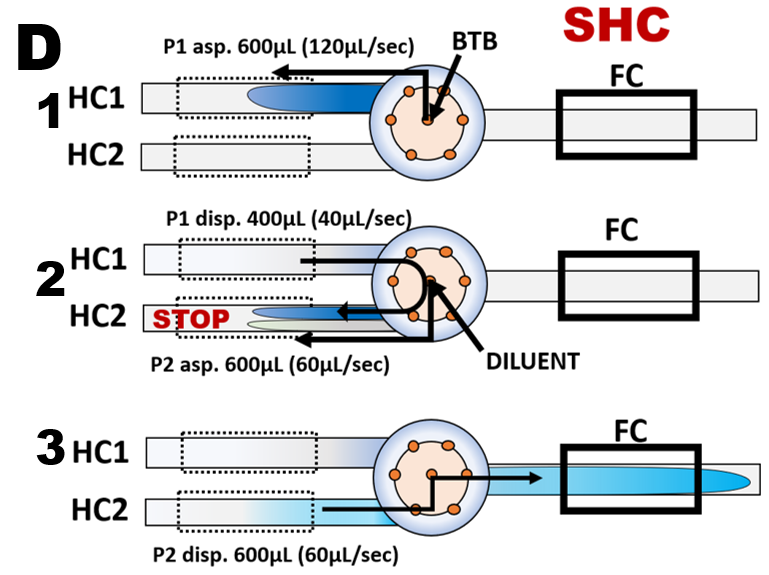
while the following steps are controlled by software protocol (E):
- sample (blue) is aspirated into holding coil (HC1)
- sample is transferred into HC2 simultaneously with reagent (colorless), added at the confluence point. The mixing ratio of sample with reagent is controlled by flowrates of the sample and reagent streams (S+R = 3+2)
- the flow is stopped for 20 seconds to simulate SHC mode
- the reaction product (light blue) is moved into flow cell for monitoring.
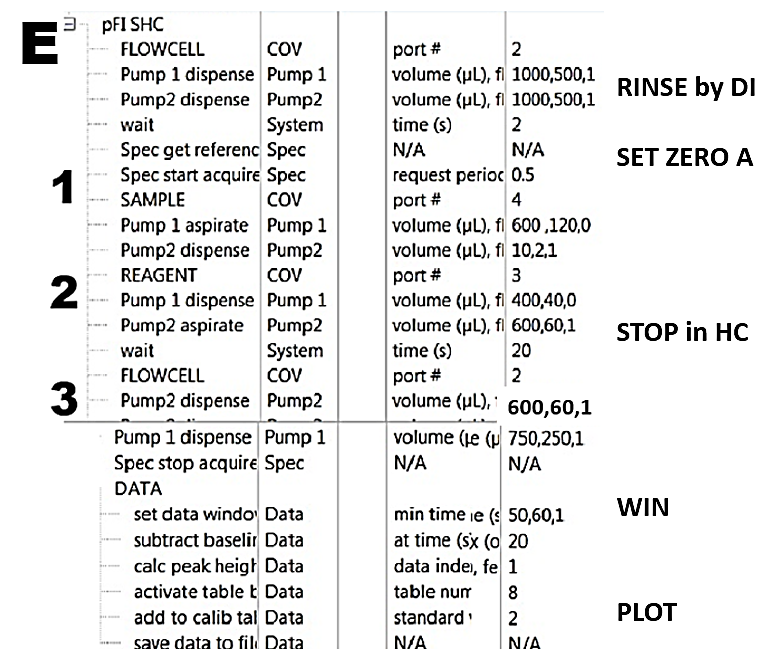
By injecting series of standard solutions of BTB series of peaks are recorded, shown superimposed (F). The maximum absorbance value, collected within WIN interval and adjusted by baseline (BS) value is used to construct calibration graph (G) that is strictly linear with r.s.d. better than 2%.
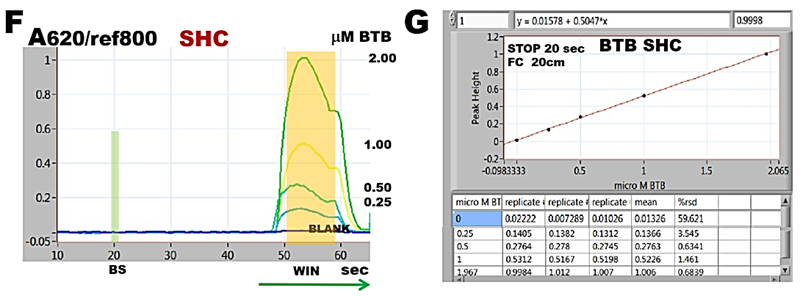 It follows from this experiment that microfluidic manipulations and performance of spectrophotometer are well reproduced and the software protocol is suitable for automation of reagent based assays with spectrophotometric detection. It is recommended to use this test when installing new instrument or developing new method.
It follows from this experiment that microfluidic manipulations and performance of spectrophotometer are well reproduced and the software protocol is suitable for automation of reagent based assays with spectrophotometric detection. It is recommended to use this test when installing new instrument or developing new method.
An example of single reagent assay is determination of nitrite, based on Griess reaction. Since this is the most frequently used assay for this analyte in sea water, we shall use it here as an example, how it can be automated in SHC as well as in SFC format. This chromogenic reaction produces an azo dye, which is pink in its protonated form (ε = 4.6E04 at 550 nm) (Hatta 2021, Steimle 2002).
By replacing diluent in BTB protocol (D, E), with Griess reagent series nitrite standards were analyzed, while spectrophotometer was adjusted to monitor absorbance values at 550 nm. The series of thus obtained absorbance/time measurements are shown superimposed on (H). The calibration graph (I) obtained by peak height and nitrate calibration shows linear dependance and acceptable reproducibility (rsd 1.5%) of nitrite determination with limit of detection LOD = 46 nM N.
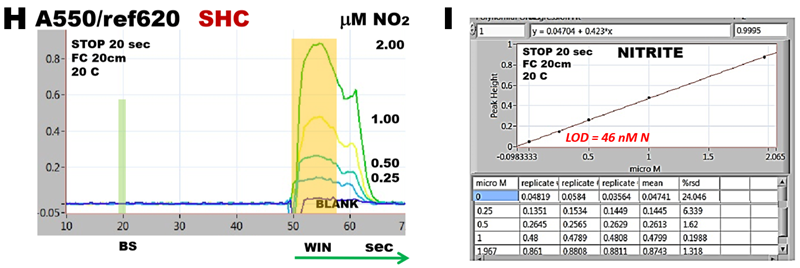 Two reagents based assay, the determination of phosphate, uses spectrophotometry to monitor formation of phosphomolybdenum blue (PMoB), at 880nm, (ε = 3.3E04). The PMoB is produced in two steps; first yellow phosphomolybdate (PMo) is rapidly formed, followed by gradual formation of the PMoB compound upon addition of ascorbic acid. Both reactions are performed in a strongly acid solution (pH 0-1) to prevent interference from molybdenum blue (MoB) as well as from silica molybdenum blue (SiMoB), which is formed in the presence of silicic acid.
Two reagents based assay, the determination of phosphate, uses spectrophotometry to monitor formation of phosphomolybdenum blue (PMoB), at 880nm, (ε = 3.3E04). The PMoB is produced in two steps; first yellow phosphomolybdate (PMo) is rapidly formed, followed by gradual formation of the PMoB compound upon addition of ascorbic acid. Both reactions are performed in a strongly acid solution (pH 0-1) to prevent interference from molybdenum blue (MoB) as well as from silica molybdenum blue (SiMoB), which is formed in the presence of silicic acid.
To automate PMoB method a four step SHC protocol (J) is designed to hold reaction mixture during the third step, for 20 second long incubation period to facilitate reduction of PMo to PMoB. During the fourth step reacted sample flows through the detector while peak is recorded at 880 nm (K). The resulting calibration graph (L) shows linear response, acceptable precision (rsd 2 %) and limit of detection LOD = 366 nM P.
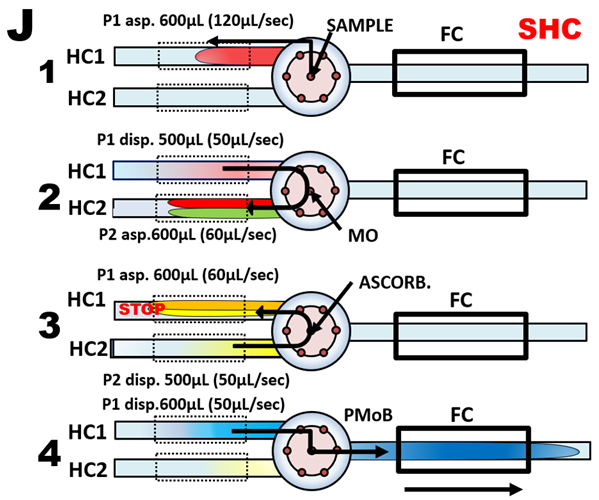
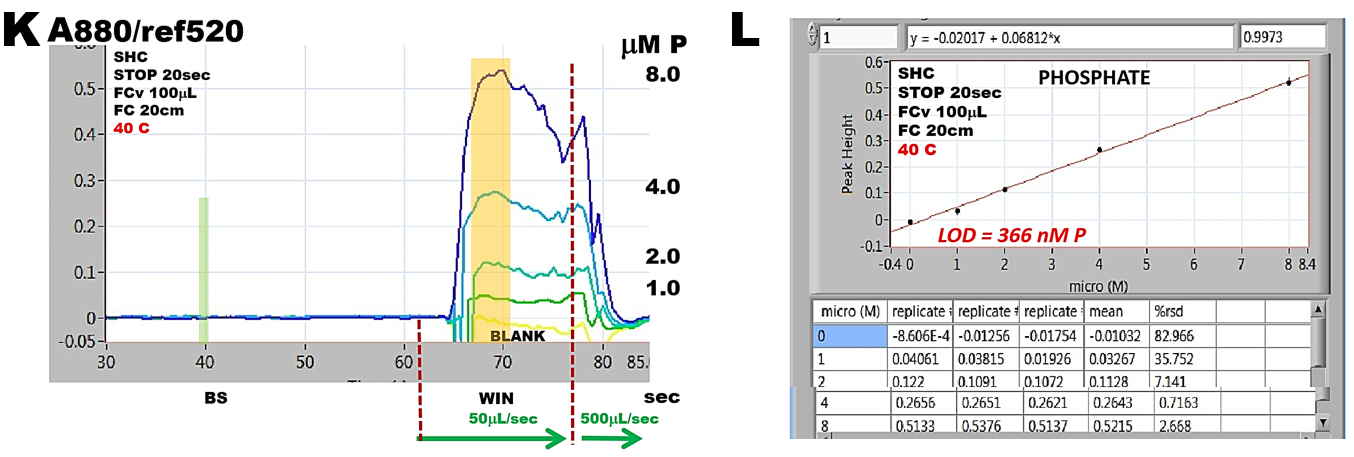 In summary, pFI-SHC method can accommodate a variety of reagent-based assays in the same lab-on-valve configuration by using three, four or five steps flow programming. SHC assay is easy to optimize and its output - a peak, proportional to analyte concentration, is the same as in all conventional flow-based techniques.
In summary, pFI-SHC method can accommodate a variety of reagent-based assays in the same lab-on-valve configuration by using three, four or five steps flow programming. SHC assay is easy to optimize and its output - a peak, proportional to analyte concentration, is the same as in all conventional flow-based techniques.
Mariko Hatta, Jaromir (Jarda) Ruzicka, Christopher I. Measures, Madeline Davis “Programmable flow injection in batch mode: Determination of nutrients in sea water by using a single, salinity independent calibration line, obtained with standards prepared in distilled water “Talanta 232 (2021) 122354
ET. Steimle, E.A. Kaltenbacher, R.H. Byrne, In situ nitrite measurements using a compact spectrophotometric analysis system, Mar. Chem. 77 (2002) 255–262.